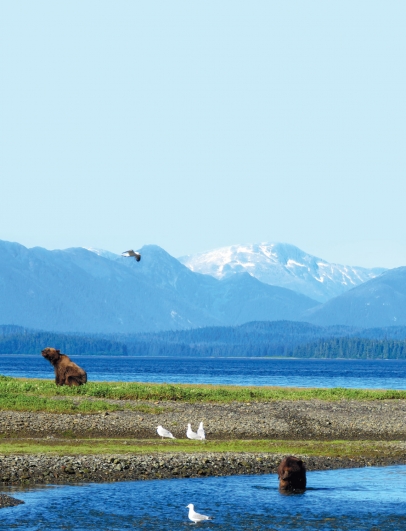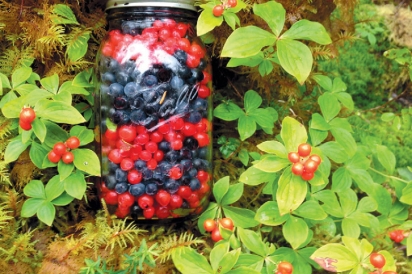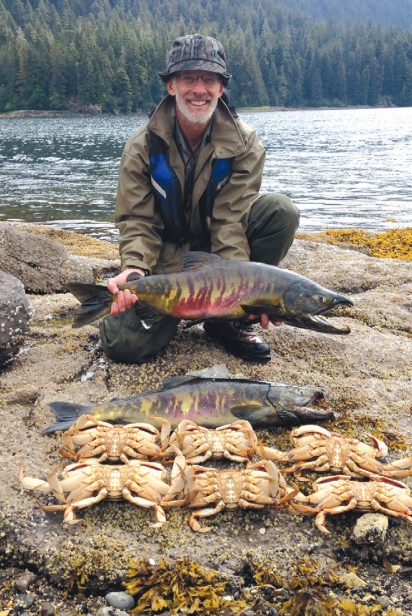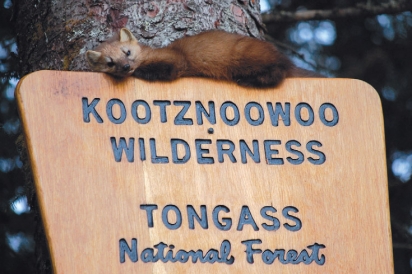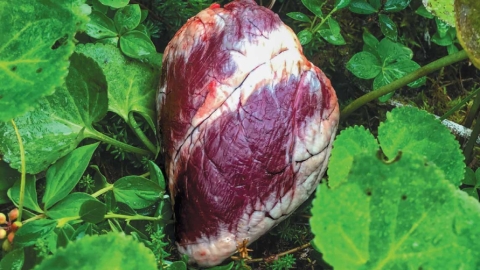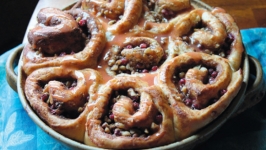A Foraging Epic in the Fortress of the Bears
In June of 2014, a floatplane dropped off Bruce “Buck” Nelson in a bay on Admiralty Island in northern Southeast Alaska. He planned to survive on only what he foraged and caught. He took no food, not even a bag of rice or a few granola bars, though he did have salt and pepper.
Admiralty Island’s true name is Kootznoowoo. Translated from Lingít, the language of the Tlingit people who have lived in Southeast Alaska since time immemorial, it means “Fortress of the Bears” or “Bear Fort.” The island has an exceptionally dense population of brown bears. Nelson was not very familiar with the island, or with Southeast Alaska, but he figured the region’s temperate rainforest and rich ocean would provide plenty of food. He set up camp on a peninsula away from well-worn bear trails. Dreaming of bushes heavily laden with berries and streams full of salmon, he set out to gather food. Things quickly turned serious. It was the end of June. The berries had yet to ripen, and the salmon had not yet arrived.
“I’d assumed berries would be a slam dunk type of food and that salmon would be running right away,” Nelson recalled over the phone.
Nelson admitted those first days were “psychologically challenging and intimidating.” The idea of failing scared him more than brown bears or starvation. Nelson is a retired Alaska smokejumper who has made an impressive number of long, often solo, human-powered adventures. When I interviewed him, he’d just gotten back to his cabin in Fairbanks after hiking the Great Divide Trail for two months. During Nelson’s childhood on his family’s dairy farm in Minnesota, he and his brother would venture into the woods near their home to make what he calls “living off the land trips.” They’d eat grouse and squirrels they hunted, wander and sleep out for days. Nelson loved those trips and dreamed of doing one on a much grander scale and in a wilder place, which was what took him to Admiralty Island nearly a half-century later.
After a few days without food, Nelson explored a new creek and with his fly rod caught five Dolly Varden trout. Most Alaskans stick their noses up at eating “Dollies,” but they were delicious to Nelson. He spent a lot of time at ground level exploring flora while consulting the two guidebooks for edible plants he’d brought along. There’s an old saying in Southeast Alaska: “When the tide is out, the table is set.” It refers to all the clams, limpets, mussels, and other mollusks that can be easily gathered in the intertidal area. Due to climate change, paralytic shellfish poisoning (PSP) has become more common and unpredictable. So even though the beach offered a seemingly limitless, easy supply of food, Nelson stayed away.
The days wore on and Nelson, already wiry, lost weight. But each day he gained a better understanding of the ecosystem and potential food sources. He was obsessed with the idea of catching a halibut, though he knew nothing about halibut fishing. He spent numerous days in his inflatable kayak unsuccessfully jigging for one. About ten days in, a few salmon entered the stream and offered him his first sense of food security. He began to have luck catching Dungeness crab. He canned excess meat in a pressure canner. Soon chum and pink salmon were running steady. Nelson would sometimes “take turns” with bears at fishing holes on the creeks. None of the bears gave him any problems, even the couple times they blundered into his camp during the night.
Nelson was never lonely. Humpback whales, killer whales, seals, mink, deer, and numerous other animals kept the bay busy. He learned all the hype about the rains of Southeast Alaska was true, noting mold growing on his ball cap and paperbacks. It was a different sort of adventure than the epics of his past. In early August he shot a young buck and roasted its backstrap over the fire as he canned a batch of venison.
“It was a huge deal. I didn’t lose any weight after that,” Nelson said.
A few days later, he caught his first halibut, a 50 pounder. He had all the meat he could eat after that and spent more time foraging plants to vary his diet. He estimates that he ate three pounds of meat, a quart of berries, and a pile of greens each day. By September, Nelson believed he was on the verge of gaining weight but admitted he needed more fat to put on a decent reserve.
On September 8, after 70 days of eating only what the island provided, a floatplane arrived and whisked Nelson back to civilization. He felt sharper than normal and physically strong. His first meal was a large pizza covered with every topping on the menu, followed by a large serving of ice cream. Many people dream of doing something like Nelson did. He’d probably be the first to encourage it, but he stresses the importance of being realistic about your ability and taking time to build your skill set. The Alaska backcountry is not a gentle or forgiving place.
Asked his biggest takeaway, he told me, “Most of us are so spoiled. There was a time when if you weren’t successful fishing and hunting, you didn’t eat. More than anything, it made me thankful for food.”
Note: Nelson wrote a book about his Kootznoowoo trip: Alone in the Fortress of the Bears. You can find more about his books and DVDs and follow his adventures at bucktrack.com.
This piece was first published in Issue 27, the Spring 2023 edition of Edible Alaska.


